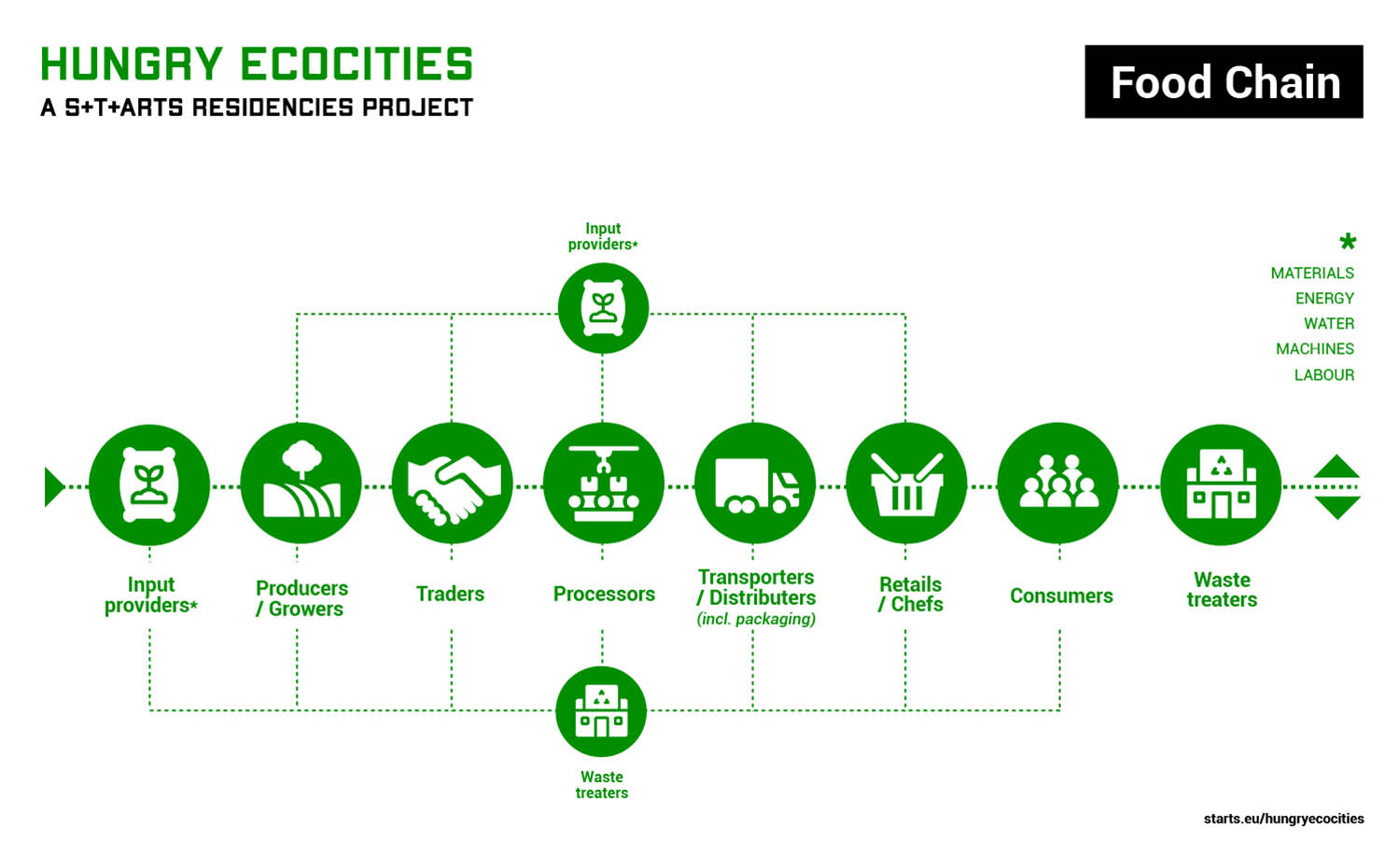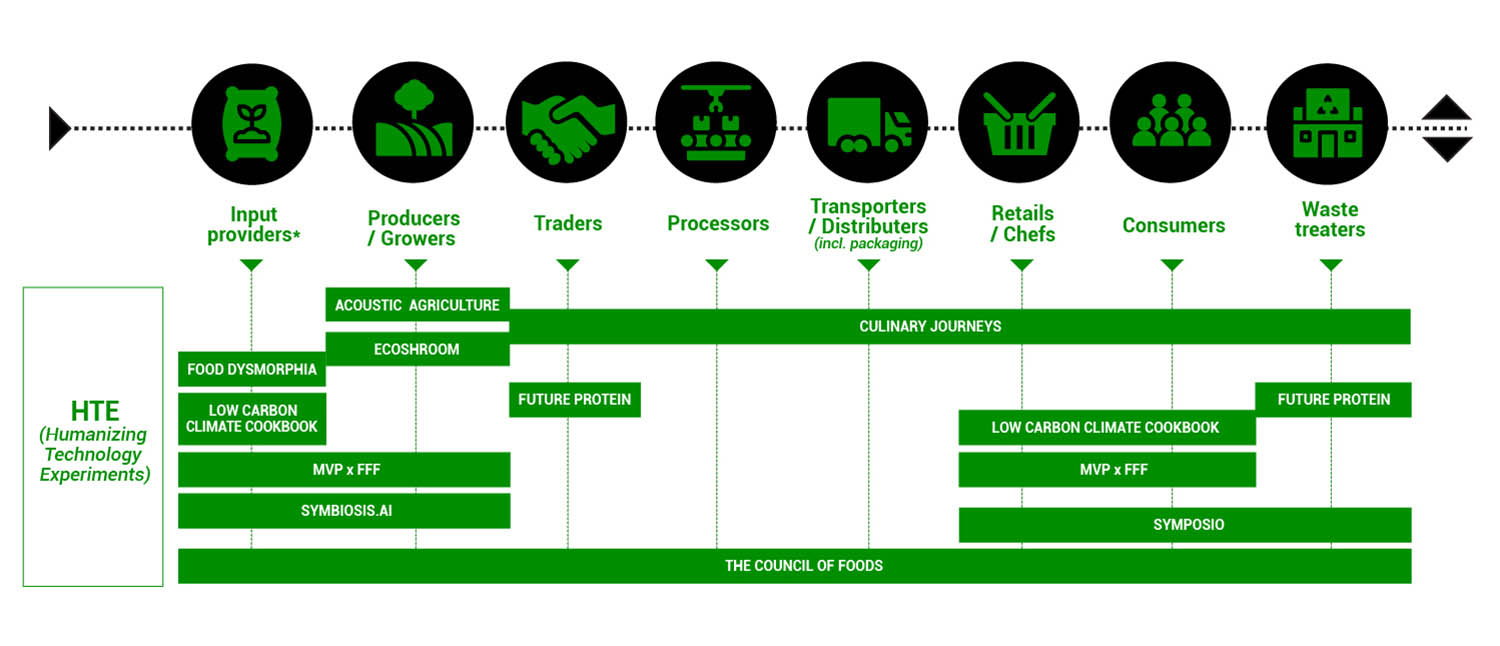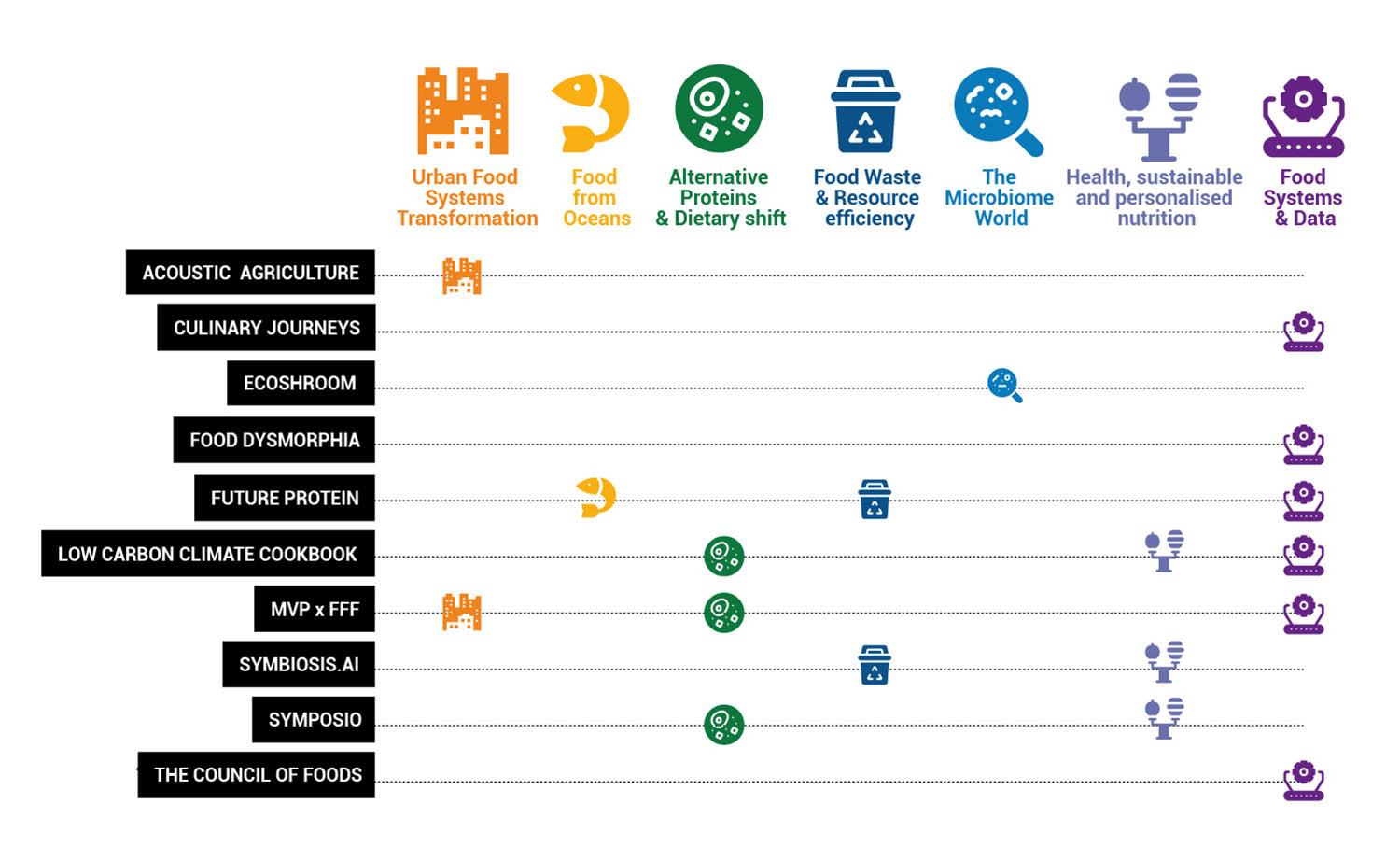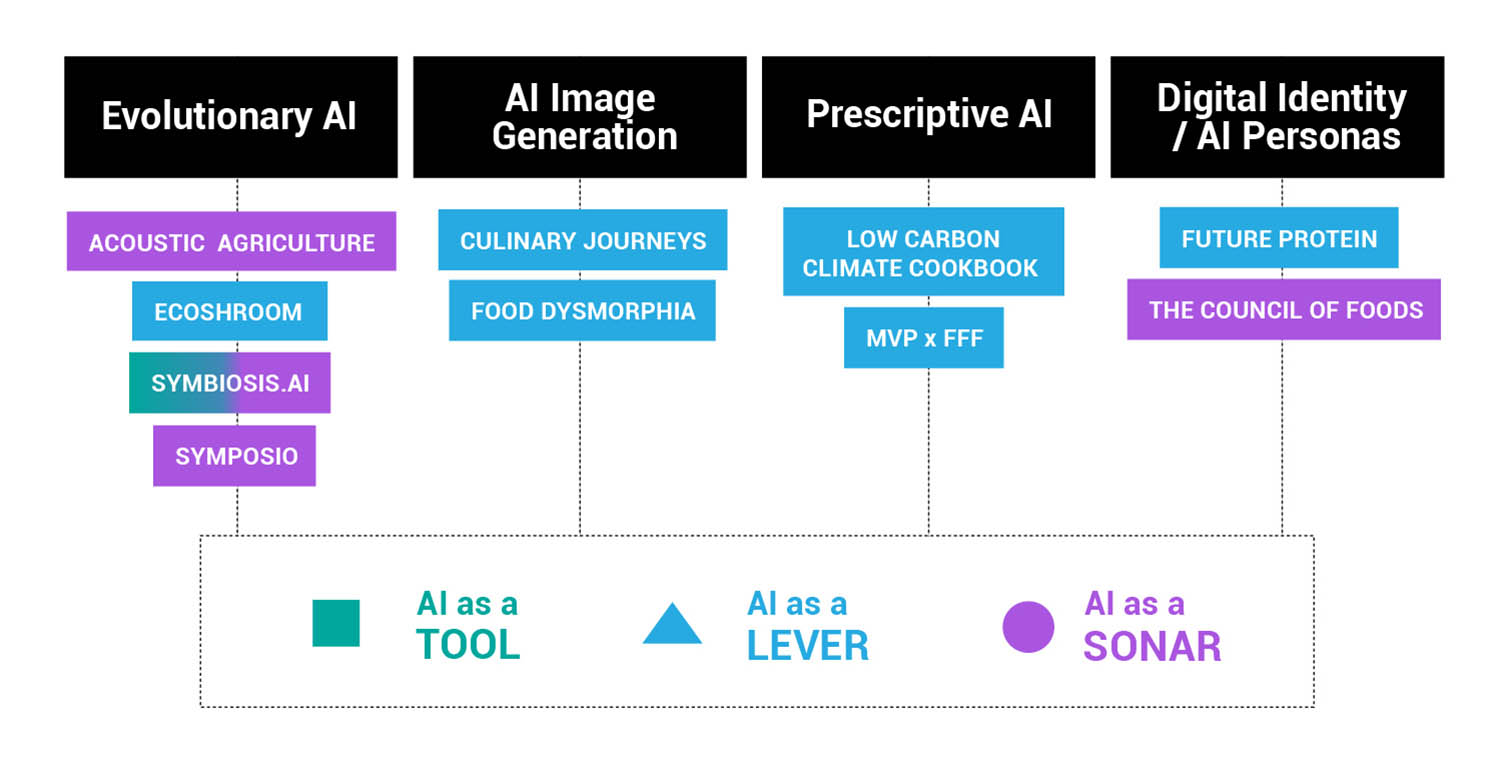Hungry EcoCities: A journey through rebuilding the food chain
We need a future where we use resources responsibly to produce and consume food. In our current system, we fail to live up to this necessity to realise a world where nutritious food is available to all. This system failure is happening in many ways and in many places. Trying to grasp the immensity of the challenge seems a mission impossible. That is why we start small, by experimenting in various ways how we could develop new perspectives, new concepts and new technological opportunities that can intervene in parts of our current food system, with the aim to make the world a better place.
The first period, we focussed on setting the stage for the goals and ambitions of Hungry EcoCities, defining the directions of interest and inviting artists to react to our open call. This September 2023, we have started work on 10 art-driven experiments which are being run in multi-disciplinary teams consisting of artists, researchers, creative studios and businesses. Each experiment, which we call a Humanizing Technology Experiment, zooms in on exploring, developing and demonstrating responsible AI and digital technological tools. These tools, developed as prototypes for system interventions, aim to reduce resources used up in the production, processing, transportation, consumption and waste treatment of food.
Currently, we are in the early stages of development of the experiments, and we need to reflect on the ideas behind them and how they relate to the food chain, the Food 2030 EU pathways for action and AI development are introduced. In this overview article, we will relate to their new perspectives and contributions to the food chain.
Developing along the food chain
The food chain is extensive and includes many steps before a seed eventually turns into a meal. In all of these steps, people, infrastructure, equipment and natural resources are needed to bring that seed one step closer to the meal it eventually becomes. Below overview image shows the food chain, which we use as a reference within Hungry EcoCities:

Input providers
The chain starts for us with what we call input providers, the providers of necessary resources to get the process going. However, inputs are required across the chain, therefore input providing is not something which stops. One example is the Ecoshroom experiment, where we aim to bring one of the best hidden titans of plant health and growth support into the light: mycorrhizal fungi. These intelligent systems of trade between mushrooms and plants are largely unexplored for what they actually do and, more importantly, why. By prototyping an evolutionary AI to learn about the intelligence of mycorrhizal biological systems, we aim to push art-driven experimentation to the edges of the scientific and biological growing domains.
Producers / Growers
Producing or growing food is a capital and energy intensive part of the chain where a lot of changes are happening. From urban growing possibilities; think of vertical farming or food forests, to shifts from intensive monocultural growing to nature inclusive or biological growing practices. Forms of growing are a root cause of many challenges the food industry faces today. In five of the experiments, new concepts intended to empower new forms of growing are being developed. An example is the Acoustic Agriculture experiment, in which we explore the impacts of urban noise pollution on plant growth by developing an evolutionary AI-plant communication algorithm. This system prototypes how AI systems can be developed as non-human agents capable of helping humans understand other non-human agents. Ultimately, this experiment aims to develop a soundscaping ‘shield’ which protects urban grown crops from unhealthy sound pollution.
Traders
Trading of harvested foods occurs in different forms; at auctions, directly with the farmers/growers, or through larger corporations, just to name a few. In these value-oriented environments, the real value or real cost of production is mostly overlooked. In several experiments, we try to create tools to increase the diversity of voices heard when it comes to trading our soon to be meals. Take for example the Food Dysmorphia experiment. Here, we explore how we can create a reality filter which exposes the reality costs of the food you are about to consume. In this experiment, we argue that market capitalism has placed full responsibility for decision making with the consumer (what the consumer wants / the customer is king), yet, the consumer has been given no tools nor means to actually act upon this responsibility and make considered choices around sustainability or ethics. By developing an AI generated image morphing filter, hidden realities can be exposed and turned into actionable information.
Processors
Processing and distribution are that part of the food chain preoccupied with logistics, packaging, warehousing. A part of the chain which relies heavily on (public) infrastructure, usage of materials and natural resources to operate. To get a better understanding of this part of the chain, the experiment Culinary Journeys has come to life. In this experiment we intent to develop an AI generated storytelling methodology to turn food logistics data into documentary like, first-person, movies. With the aid of image generative AI, a deeper connection with the food we consume can be established through perspective changing, allowing a form of embodiment of foods. The underlying idea is that, only once we know better where our foods come from, we can start thinking about making chains more sustainable.
Retails / Chefs
The part of the food chain most visible to us is the part where food meets mouth; retail, cooking and consumption. We make decisions in supermarkets, in our kitchens, at restaurants, on a daily basis. Many of our experiments look at this part of the chain in one way or another, intending to bring to life interventions which enable a healthier, more sustainable and more just diet for all. An example is the Low Carbon Climate Cookbook experiment. Here, a new perspective on dietary decision-making is being introduced. Instead of being carnivorous, vegetarian or vegans, we should become ‘climavores’ instead. In this experiment, a prescriptive AI is created to prescribe to chefs and home cooks how to cook traditional recipes in low carbon ways. A recipes tool, the intent of this prototype tool is to source or replace ingredients based on low carbon impact while maintaining authenticity.
Waste treaters
Finally, after the seed has made its way to the meal and has been consumed, we are left with the waste. It marks the end of the chain, but not only. Throughout the chain waste is being created which requires treatment to reach the circular, carbon free society we need. This enormous waste pile which is the largely unseen witness of our broken food chain remains largely untreated till this day. In our experiment Future Protein, waste treatment becomes a part of a value-based strategy of cultivation of mussels. While mussels are a protein rich and important part of our diets, the growth of aquaponic mussel farming has stagnated across Europe due to the imbalance between costs and value created. This is a market mistake, for mussels contain much more value than the fruit consumed. The shells are considered food waste in our current system, but, being made out of calcium carbonate almost completely, have the potential to be a strong, flexible and durable biomaterial for many purposes. In this experiment, a mussel ID system is being conceived to predict the maximum mussel value throughout its lifetime, and beyond.
We’ve recognized common themes and trends that span various experiments (further details can be found here):
● Integration of technology in agriculture
● Sustainable food production and environmental impact
● Empowerment through knowledge and awareness
● Cultural and social engagement with food.
Hence, the 10 Humanizing Technology Experiments in Hungry EcoCities cover various elements in the food chain and make us question and rethink this system.
This infographic links the projects to the different steps in the food chain as partly described above. As you can see, we come to the following statistics: 5 x Input providers, 5 x producers / growers, 2 x traders, 2 x processing and distribution (packaging / logistics), 5 x retailing / chefs & consumption (combined) and 4 x waste treatment.

Analysing the 10 Experiments
In the next articles, we will focus on the Food 2030 EU pathways for action and AI development that are central in these experiment projects. As a teaser, we developed two infographics on these topics and a short description below.

From the 11 identified pathways to achieve the EU Food 2030 goals, the current experiments will contribute to seven. It varies from empowering communities, to reaching circularity, to protecting the climate, towards improving nutrition. The seven ambitions we have a match with are:
● Food Systems and Data
● Healthy, Sustainable and Personalised Nutrition
● Alternative Proteins and Dietary Shift
● Food Waste and Resource Efficiency
● Urban Food Systems Transformation
● Foods from Oceans
● The Microbiome World
AI and digital technology play a central role in all projects, from utilising AI for the generation of visual content to leveraging machine learning for data analysis in agriculture. The integration of AI in these projects not only facilitates research and development but also enables more efficient, data-driven decision-making processes.
We have identified 4 different clusters for AI developments: Evolutionary AI, AI image generation, Prescriptive AI and AI personas / digital identity. At the same time, the intent of using these tools differ, some look at it to improve existing processes, while others work towards unveiling hidden technological opportunities and unshadow unforeseeable external situations.

Hungry EcoCities is at the forefront of innovation in sustainable food systems. As we delve deeper into this journey, we invite you to join us in moving towards a more equitable and technology-driven future of food production and consumption. Together, we aim to make nutritious, environmentally responsible, and ethically sourced food available to all. Stay tuned for our upcoming explorations into the future of food systems.
This project has received funding from the European Union’s Horizon Europe research and innovation programme under grant agreement 101069990.

